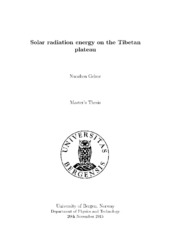| dc.description.abstract | To gain a thorough knowledge of the solar energy resources on the Tibetan Plateau, measured and modeled solar irradiance levels on the Plateau from July 2010 to September 2013 are considered. The Tibetan Plateau lies in southwest China between 27.3 °N and 36.4 °N at an average altitude exceeding 4500 meters, where the amount of overhead atmosphere is reduced to almost one half of the amount at sea level. The combination of low solar zenith angles with low atmospheric attenuation and good weather gives high solar radiation levels, which could be exploited by solar power plants. To quantify irradiance levels as well as their spatial and temporal variations, pyranometer measurements of the solar irradiance were recorded every minute throughout the years 2010 to 2013 in Lhasa (29.6 °N, 91.2 °E, 3683 m), Nagqu (31.5 °N, 92.1 °E, 4510 m), Tingri (28.7 °N, 87.1 °E, 4335 m), and Nyingchi (29.7 °N, 94.7 °E, 2995 m). The high irradiance values (around 1200 to 1300 W m^-2) at the Tibetan Plateau are found to be comparable with those at the Top of the Atmosphere (TOA) (1300 W m^-2). The yearly solar energy received by a horizontal surface is found to be about 7.6 GJ m^-2 in Lhasa and 6.8 GJ m^-2 in Nagchu. As expected, the highest irradiance values are observed at around 06:00 UTC (local noon), and the daily radiant exposure on a clear winter day is only about 54 % of that on a clear mid summer day. Based on the monthly averaged daily radiant exposure, Tingri has the best solar energy resource of the four sites and Nyingchi has the lowest. Lhasa has a richer solar energy resource than Nagchu. A radiative transfer model (AccuRT (Hamre et al., 2014)) is used to examine the air quality by comparing modeled results with spectral radiometer measurements recorded during one day at two sites in mainland China and two sites in Tibet. The retrieved spectral transmittances show that the atmosphere above the two sites in Tibet is much more transparent than that above the sites in mainland China. Applying AccuRT, we also found out the weather has a more significant impact on the yearly radiant exposure (up to 23% variation between the four sites) than latitude (2% variation) or altitude (2% variation). Finally, sensitivity of irradiance levels due to variations in the aerosol and cloud optical depths were investigated. The yearly radiant exposure was reduced by aerosols by about 3% to 6% for typical aerosol optical depths in Tibet (0.17 - 0.27 at 580 nm). The combined effect of aerosols and clouds reduced the yearly radiant exposure by 15% in Lhasa and 23% in Nagchu. To cover the yearly power consumption in the Lhasa region, about 5.3 to 5.9 km^2 of horizontally oriented solar panels are necessary assuming a light-electricity transformation efficiency of 16% (Narbel et al., 2014) and a yearly radiant exposure of 7.6 and 6.8 GJ m^-2, respectively. | en_US |
